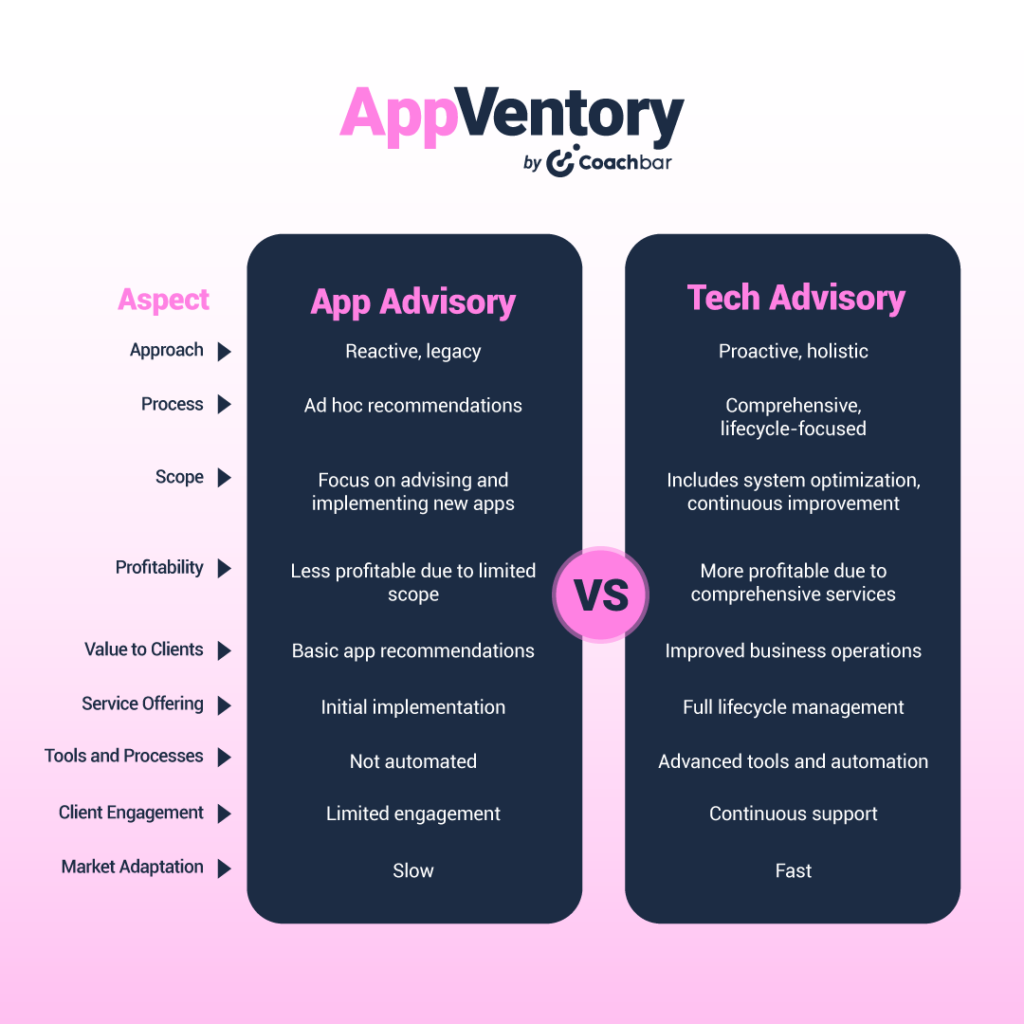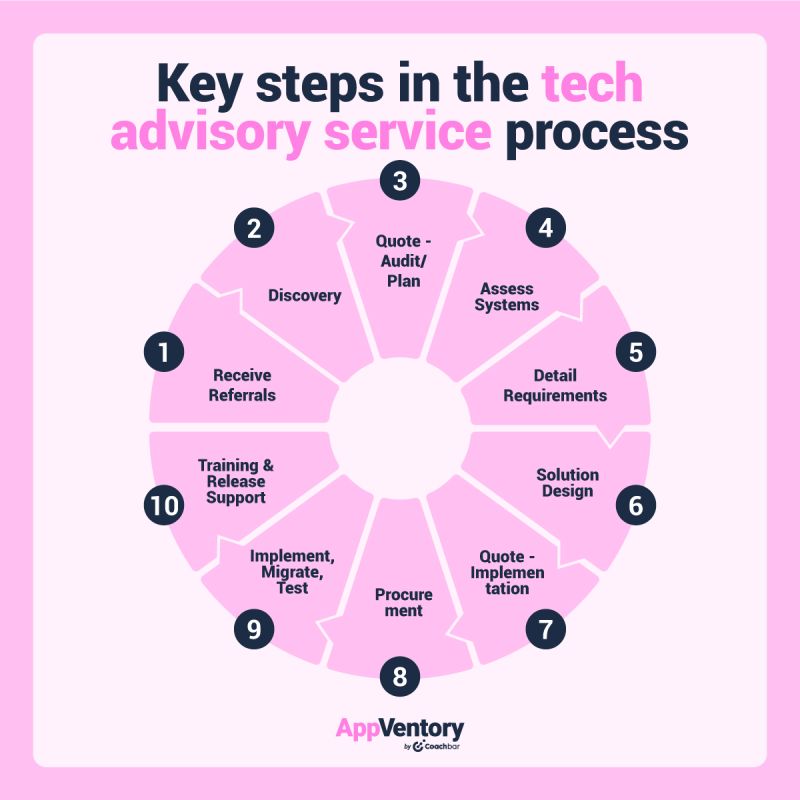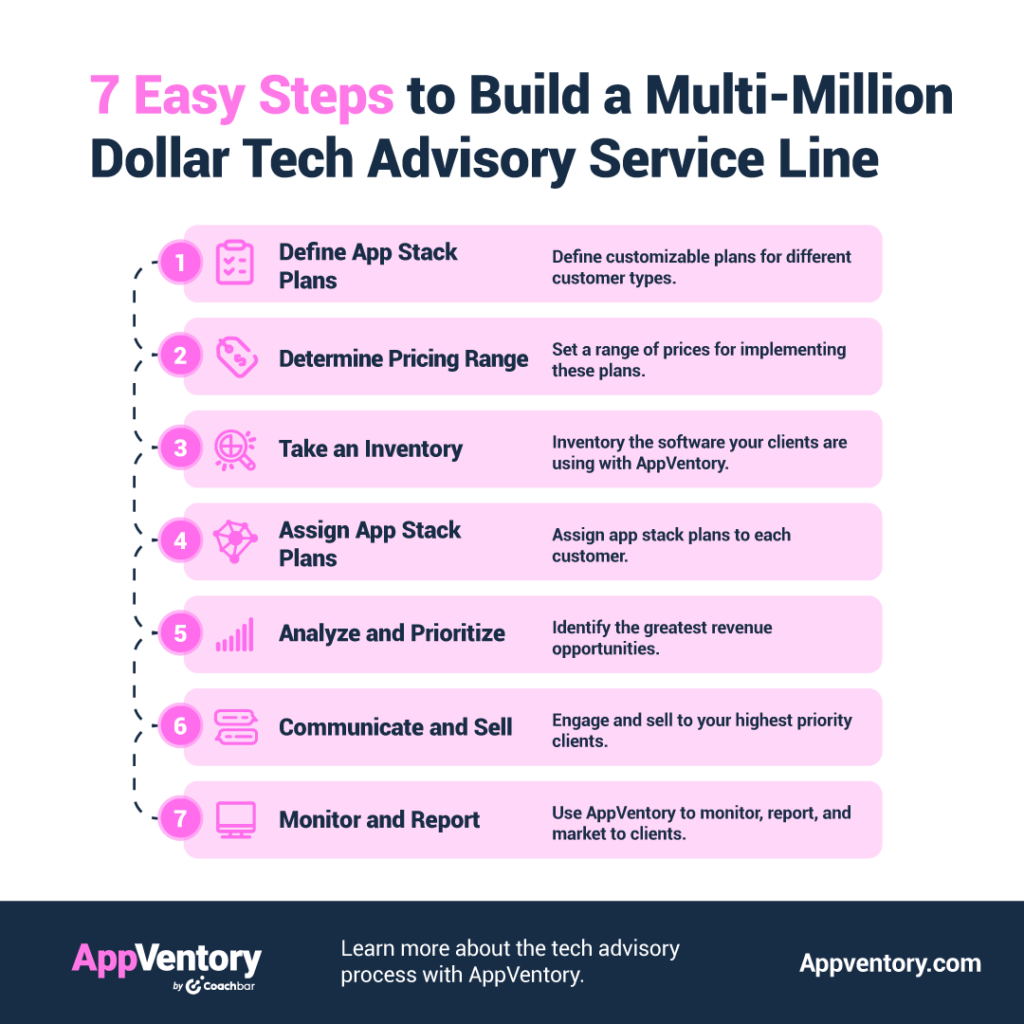The app and tech advisory space has undergone significant change in recent years. What was once a niche offering with ad hoc processes is evolving into increasingly data-driven and profitable services. Accounting firms and cloud system implementation providers are unlocking new fee-generating opportunities by streamlining and automating tech advisory solutions.
In this Ultimate Guide to Delivering Tech Advisory Services at Scale, we explore the challenges, emerging opportunities, best practices and key steps to achieving an efficient process.
Introduction to AppVentory’s guide to delivering tech advisory services in a cloud-first era
Our tech advisory services guide aims to help you better understand the potential of gaining data-driven insights into customer tech stacks, how these can generate revenue opportunities for your firm and what time- and cost-savings are possible with auditing tools like AppVentory.
We highlight why it’s time to modernize app advisory and make services more efficient and profitable. You’ll learn about the challenges advisors face and how to overcome them, plus the solutions transforming the sector and what an effective tech advisory process looks like.
By the end of this guide, you’ll have a comprehensive understanding of the tech advisory process and practical steps to transform your offering.
What is tech advisory and what does it involve?
Tech advisory is an area of software system design, consultation, system implementation and integration where solution providers help businesses select and adapt their tech stacks to align software solutions with their operational needs and processes, before integrating tools, implementing new solutions and onboarding and training users.
The role of tech advisors is to assess existing systems and processes, identify potential issues and areas for improvement, and provide expert guidance for system implementation, optimization and continuous improvement.
Understanding the importance of tech advisory services
App advisory services were once viewed as more of a hindrance than a revenue-generating opportunity. There wasn’t much money in it and services were time-consuming. Now, with the vast array of cloud software solutions available and the increasing interconnectivity of apps and systems, tech advisory services can be more scalable and profitable if conducted efficiently.
According to The Business Research Company’s 2024 Technology Advisory Global Market Report, the market will grow from $157.91 billion in 2023 to $164.48 billion in 2024. This trend is expected to continue, with forecasts predicting the market to grow to $196.66 billion in 2028 at an annual growth rate of 4.6%.
Delivering tech advisory services can easily be a multi-million dollar revenue line for large accounting firms [anchor link down to the checklist section] and offers many benefits to modern accounting firms. We understand why many firms focus on compliance, seeing this as more important and cost-efficient than advisory services. But today, efficient, repeatable advisory services can be a point of difference for firms and a huge value add for existing clients which, in turn, makes them even ‘stickier’.
Why it’s (overdue) time to professionalize tech advisory services
App advisory has been around for more than 10 years, emerging from the launch of cloud-based accounting solutions like Xero. It changed the space and provided a niche for firms to offer supporting services to help businesses understand where they could improve their systems and processes, and adopt new apps and solutions.
However, most app advisors, system integrators and techy accounting firms haven’t moved these services forward and processes have stagnated. As the cloud era has snowballed, app advisory services are still catching up.
The difference between app advisory and tech advisory
Think of app advisory as a legacy, reactive approach where firms simply make recommendations to clients, with ad hoc processes for advising on and implementing new apps. A typical result for firms following this approach is to sell app advisory and implementation services to 10 to 50 clients per year.
Tech advisory has a more holistic scope. It’s a more profitable and valuable advisory service offering that’s more concerned with doing things to improve your client’s business with new technologies throughout their lifecycle. Professional tech advisory is a business line of services that can easily surpass a million dollars per year by taking an automated and holistic approach to identifying the most profitable, repeatable services for sets of functionally similar businesses across your entire client base.

Many firms overlook things like following up with clients months after completing system implementation projects and upselling opportunities for further enhancements. Plus, there is likely untapped revenue from within your client base, where many companies are prime targets for receiving advisory services.
The perceived time-consuming nature of these services is partly to blame, but there’s been a gap in the market. There weren’t any suitable tools for ‘professionalizing’ and ‘automating’ app advisory services and useful tools, like Xero HQ’s app discovery tool, are no longer available. It’s a shift in approach made possible by smart new advisory tools, such as AppVentory, which empowers advisors to deliver streamlined tech advisory services at scale.
The tech advisory process today (and tomorrow)
There are two main tech advisory types:
- Straightforward accounting/fintech advisory with minimal complexity – easy to quote for and fits many clients with the same stack, such as Xero, Dext, etc.
- Complicated bespoke solution design and implementation – bigger in scale and requiring a more ad hoc approach, with custom builds and complicated integration needs.
A new generation of tech advisors is shifting from the bespoke offering to a more automation-powered offering where new tech stack implementations can be managed by buckets of clients with similar profiles. It’s a modern, repeatable and scalable model which enables firms to provide more straightforward plans, pricing, and implementation timelines.
The next-gen tech advisory process can be broken down into three key phases:
- Onboarding
- Ongoing ‘year-in-the-life’, which can include phased app implementations and/or ongoing high-margin tech support plans
- Offboarding
Onboarding involves client identification and assessment steps, quotes and agreements, implementation and testing, and user training and sign-off.
In the year in the life of your clients, advisors have responsibilities like compliance, reporting and record-keeping (in the initial quarters), before preparing for the year ahead, such as strategic and financial planning, app assessments and proposed refinements, and reviewing changes and confirming fees for the following year.
The final phase, where clients have chosen to exit your services, consists of offboarding tasks like handover documentation, ceasing subscriptions/stopping apps and updating client records.

10 steps in the modern tech advisory process
So, let’s look at the key steps in delivering tech advisory services that are repeatable, scalable, and profitable, whilst considering the challenges you may face and how to address them.
1. Client identification
The first step is to identify suitable clients for tech advisory services. This can be through referrals, exploring and running marketing campaigns to your client base, or other routes.
This is the step many firms struggle with, as they don’t have adequate tools and data to understand which clients need tech advisory support or the process alignment to ensure internal teams take advantage of new project opportunities.
What’s involved:
- Assessing the needs of the prospective clients
- Filtering your client base to identify your ideal advisory customers by business size, type and tech stack
- Qualifying leads/existing clients to determine suitability
Challenges to consider:
- Identifying suitable client opportunities
- Scanning your entire client base, identifying and prioritizing clients you want to sell to
- Boosting credibility and trust in your advisory capabilities
- Convincing clients/prospects about the value of advisory services
Recommendations:
The best way to identify suitable clients is to have a clearly defined target market, persona profiles and predetermined criteria for qualification. This can easily be done in an automated manner using AppVentory. Once you’ve identified suitable clients, you must clearly communicate your advisory service benefits.
AppVentory enhances your firm’s capabilities to identify suitable candidates for tech advisory services. Essentially, AppVentory is a tech advisory practice management tool with purpose-built capabilities, tightly aligned with running highly profitable tech advisory service lines.
Specifically, the software allows you to set up ‘app stacks’ to segment clients into buckets, depending on common/relevant app profiles. For example, you can set up a default app stack, which includes Xero, Dext, GoCardless, etc, and then, say, an ecommerce app stack, with additional apps used in space, such as A2X and Cin7.
You can add all of your clients into AppVentory, which will analyze these client accounts (via integrations with Xero, QuickBooks, Google and Microsoft workspaces), segment them according to your app stacks and identify which apps and subscriptions they have (and number of users) and where there are gaps. AppVentory’s dashboards give you the full picture, showing which, and how many clients are missing certain software solutions. This equates to new leads for you to approach to sell and implement those apps and provide further advisory services.
2. Initial discovery
In the initial discovery phase, you’ll need an extensive view of your client’s existing tech stack, including what apps they’re using and any legacy systems in operation. Gathering this preliminary information is vital. It sets the scope for the advisory project and solution implementation.
What’s involved:
- Identifying the apps and software in your client’s current tech stack
- Highlighting legacy systems and processes and opportunities for improvement
- Determining the expenditure for the current tech solutions
Challenges to consider:
- Understanding clients’ unique needs
- Managing client expectations
- Getting a clear picture of the existing state of play
Recommendations:
Advisors need transparency over what the client wants to achieve and their specific operational needs, and to gather a comprehensive view of their current tech stack.
Conduct workshops and interviews with key stakeholders to gain insights, including SWOT, gap analyses, and other discovery methods. Establish clear, written agreements on scope, deliverables, and timelines to manage expectations. This will help you achieve successful project outcomes and avoid misalignment and scope creep that impact profits and lead to client dissatisfaction.
3. Quote (for systems audit and solution design)
With a clear understanding of the client’s needs, advisors must conduct comprehensive audits of current systems and processes to steer the implementation plan. So, the next step is providing a quote for a systems audit and solution design.
What’s involved:
- Creating a detailed audit and solution design quote
- Outlining why this is necessary and what’s required
- Aligning the quote with the client’s needs, goals, and budget
Challenges to consider:
- Accurately estimating the costs involved
- Articulating your discovery feedback alongside generating the quote
Recommendations:
We recommend using a standardized quoting template covering all tasks, resources, and deliverables, and building the quote from data and insights gained in discovery.
Once the quote is completed, take the client through it in detail to manage expectations and ensure everyone understands the systems audit and solution design scope. They need to know what’s involved and how it’s integral to a smooth implementation process.
4. Assessment
Once the systems audit/solution design quote has been agreed upon, you can start the tech stack and process assessment. The aim is to assess what’s being used, what’s obsolete, and areas for improvement.
What’s involved:
- Collecting information from key users about app/system usage
- Assessing quantitative and qualitative data to highlight inefficiencies and inform solution recommendations
- Determining which apps should be retained/replaced
Challenges to consider:
- Gathering accurate and up-to-date data
- Identifying the root causes of issues and inefficiencies
- Ensuring your assessment tools and techniques are efficient
Recommendations:
To guarantee an accurate assessment, combine advanced data collection tools and thorough verification processes with collaborative conversations with key stakeholders. For example, AppVentory helps you quickly learn what apps are being used and how effectively people use them, including survey features to gain qualitative data. Plus, our automation software uncovers and highlights problematic apps and areas for improvement.
Advisors can use interrogative techniques such as the ‘Five Whys’ model alongside smart audit tools, to pinpoint the root causes of issues and prioritize critical areas.
We suggest implementing a structured assessment framework and phased approach with clear steps, timelines, and milestones.
5. Detailed requirements gathering and scoping
Based on your assessment and insights gained you need to build a list of key requirements and document issues to solve.
What’s involved:
- Scoping out key requirements and expected outcomes
- Documenting risks and issues identified and how you plan to resolve them
- Communicating assessment details with the client
Challenges to consider:
- Aligning requirements with project goals
- Managing expectations and resolving any conflicts
- Ensuring requirement scope is feasible
Recommendations:
When scoping key requirements, you will inevitably uncover things that you or the client may not have expected. We suggest organizing workshops to discuss the requirements and issues identified, and how this may impact project scope and timelines/budget.
You can offer use cases to communicate requirements and take a prioritization approach like the MoSCoW method, which helps advisors and clients agree on requirements and assign their priority level.
It’s important to align on the feasibility of requirements, which can include developing testable criteria and making scope adjustments before moving to solution design.
6. Research & solution design
At the research and solution design stage, advisors use the insights, assessments and scoping details gathered to design a tech stack, crafting the best combination of apps and workflows to achieve the desired business performance.
What’s involved:
- Mapping system and process requirements with the most suitable solutions
- Determining the solutions to resolve key issues and improve efficiency
- Crafting a solution design that aligns with the client’s unique needs
Challenges to consider:
- Aligning solutions with business objectives
- Balancing emerging technologies with practicality
- Keeping potential costs within budget
Recommendations:
Follow best practices like process mapping, value stream mapping, and business impact analysis to ensure your solution design aligns with your client’s business goals and objectives.
Due to the fast-evolving digital landscape, influenced by AI and other technologies, advisors must keep up with emerging tools and trends to enhance their expertise and give clients confidence in your firm’s tech advisory services.
Although your solution design should future-proof the business for change, the new stack must primarily seek to deliver the results your client expects and solve priority issues.
7. Quote (for Implementation Project)
Now it’s time for the implementation project quote. By this point, you and your client should be well-aligned on objectives, requirements and expectations, so the quote should be clear, accurate and realistic.
What’s involved:
- Outlining the key project components
- Accurately calculating the cost of different apps, solutions, and subscription levels
- Estimating the overall project costs
Challenges to consider:
- Ensuring your calculations are accurate and cover all required resources
- Effectively communicating the need for each component and their benefits/ROI
Recommendations:
We suggest using estimate of effort (EoE) calculators (either using Excel or software) and leveraging project management tools to define key roles and responsibilities. You must create detailed scoping documents that outline key deliverables, stages, and milestones, set expectations and prevent scope creep.
Consider the principles of value-based pricing, as the quoting phase needs to emphasize the implementation’s value, long-term impact and ROI, and offer tiered pricing options to compromise on budget, where required.
8. Procurement
Once you’ve agreed on implementation costs and timelines, your firm is responsible for managing the software procurement and negotiating pricing to keep costs down.
What’s involved:
- Vendor selection and evaluation
- Procuring the most cost-effective solutions
- Liaising with vendors, establishing timelines, and managing contracts
Challenges to consider:
- Securing the best possible prices
- Coordinating vendors and third parties to project timelines on track
Recommendations:
Create a detailed procurement plan with key milestones and deadlines to set expectations with solution vendors and tech partners, and use project management tools to ensure an efficient process. We suggest using a structured vendor assessment framework that compares expertise, costs, and other criteria to support procurement decisions, incorporating vendor risk assessment.
Draft detailed contracts specifying the project deliverables and timelines and use proven vendor negotiation techniques to get the best prices and stay within budget.
9. Implementation, Migration, and Testing
The new tech stack must align with the client’s requirements and deliver on expectations, while data is accurately migrated from legacy systems to new platforms. Also, during the implementation, migration, and testing phase, your firm should strive to minimize disruption, as downtime can cause conflict and cost businesses money.
What’s involved:
- Set up the apps and use accounts
- Develop and test the integrations
- Manage the migration to and adoption of new solutions
Challenges to consider:
- System downtime – limiting disruption to productivity and operations is vital
- Maintaining data integrity, system security and regulatory compliance
- Minimizing risks and oversights
Recommendations:
For a smooth implementation, take a phased approach with fail-safes, rollback plans and measures to reduce business disruption. Clear communication throughout will keep clients onside and prevent any surprises.
Comprehensive testing is paramount, so develop a robust framework, including integration, system, and user acceptance testing (UAT). Include key stakeholders and end-users to align on requirements and expectations.
Also, implement data validation checks and security measures, including encryption, access controls, and regular audits to protect clients from data breaches and other non-compliance risks.
10. Training & Release Support
One of the main things overlooked in tech advisory services is the after-care, post-implementation, and ongoing support and monitoring steps. User training, ongoing support, and performance monitoring help to build trust and empower clients to get the best out of their new solutions.
What’s involved:
- Educating users on how to operate new systems and processes
- Providing dedicated app and software platform training
- Monitoring and tracking usage and optimizing solutions
Challenges to consider:
- Ensuring you have the resources and processes to provide responsive support and dedicated training capabilities
- Implementing effective monitoring tools to track and analyze usage, identify issues and solve problems/improve performance
Recommendations:
Developing effective training sessions to help users hit the ground running is key. Your approach can be a mixture of video walk-throughs/demos and detailed explainer sessions, accompanied by documentation and e-learning options.
You need to build dedicated tech support teams and agree on SLAs with the client. Set expectations around the support channels and how you’ll respond to queries and resolve user issues.
Finally, the undervalued ongoing monitoring step. Explore and implement monitoring tools and processes to track system performance and gather user feedback. AppVentory lets you easily monitor how your clients are adopting new solutions, plus you can manage your opportunity pipeline and track new enquiries in one place.
This is where you can deepen client relationships, detect areas to improve, and spot opportunities for upgrades that optimize client performance while adding value to your proposition.

Checklist: How to build a multi-million dollar tech advisory service line in weeks not years
As we’ve outlined, with a holistic but slick and repeatable process, the scalable potential of modern tech advisory is huge. Accounting firms and software providers have the opportunity to turn it into a significant revenue-generating service offering.
So, how can you start building this money-spinning operation? You need the right technology. With AppVentory, you get access to and visibility over your clients’ software solutions and usage, to identify issues, gaps and opportunities throughout your clients’ lifecycle with your firm. This deepens customer relationships and presents recurring phases where you can advise/support multiple clients on optimizing their tech solutions and improving operational efficiency.
Here are 7 steps to building a multi-million dollar tech advisory service line (which should take just 1-3 weeks to complete):
- Define different ‘app stack’ plans you want to sell to customers – plans can be easily customized to fit your customer types (e.g., professional services, contractors, ecommerce, etc).
- Determine a price range to charge for implementing these plans – this will help to streamline the quoting process.
- Take an inventory of the software your clients are using – AppVentory’s integrations let you quickly discover the apps and tools within their cloud infrastructure.
- Assign app stack plans to each customer to power usage and performance analysis – this enables you to build campaigns and proposals to sell tech advisory services to clients on legacy systems.
- Analyze and prioritize the clients that present the greatest revenue opportunity with the most pressing software needs – AppVentory gives you the insights to make informed decisions, ensuring time efficiency.
- Communicate with and sell to your highest priority clients – approach clients backed by data and insights gained from AppVentory.
- Utilize AppVentory ongoing to monitor and report on app adoption, usage and performance – this arms you with the data to generate more revenue opportunities from clients, from upsells, upgrades and further implementations, and drive more customer demand.
Learn more about AppVentory or reach out to us for a demo to see our transformative tool for tech advisors in action.
Summary: Transforming the revenue potential of today’s tech advisory services
For clients with complex needs, like large-scale digital transformations, a bespoke approach with a flexible process is still beneficial. However, firms with many clients can profit from a repeatable advisory framework. Modern tech advisory services allow you to manage clients in segments, offering scalable solutions for clients with similar existing tech stacks.
Using strategic frameworks and tools like AppVentory, advisors need fewer resources to analyze, design, quote, and deliver projects efficiently. This approach is faster, scalable, and profitable. By extending services to ongoing monitoring, support, and upselling, your advisory services can boost trust, loyalty, and customer lifetime value, creating additional revenue opportunities.
Introducing AppVentory
We saw a gap in the market for an automation-powered auditing tool that could streamline key stages within the tech advisory process and enable a more scalable offering.
AppVentory integrates with accounting software platforms like Xero and Quickbooks, plus productivity suites like Google Workspace and Office 365, to help you see the full picture of clients’ existing tech stacks and usage, in real-time. You can also import data (bank feeds, etc) from CSV files.
Our audit and health check tool can shave hours and days off tasks like assessing systems, quoting for solutions and scoping requirements for implementation projects.
Here are just some of the ways AppVentory can unlock your firm’s tech advisory potential:
- Client identification and selection – finding and qualifying suitable clients for tech advisory services
- Initial discovery – identify the apps and legacy software businesses are using and paying for
- Assessment – collect information from key users on which apps are useful and which should be replaced
- Quoting/negotiating price – better understand clients’ potential to increase their budgets
- Training and support – assess and monitor how well training and implementations performed post-implementation, demonstrate performance improvements, and pinpoint optimization opportunities
You give your clients the power to automate their business, and AppVentory gives you the power to automate your tech advisory process.
Learn more about our tech stack auditing tool and apply for early access to AppVentory.





